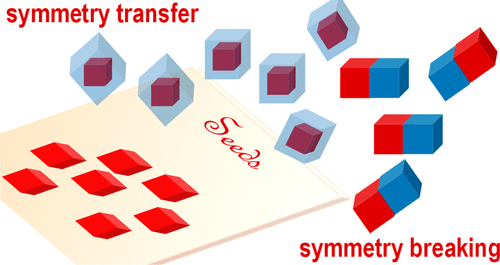当前位置:
X-MOL 学术
›
Acc. Mater. Res.
›
论文详情
Our official English website, www.x-mol.net, welcomes your feedback! (Note: you will need to create a separate account there.)
Symmetry in Seeded Metal Nanocrystal Growth
Accounts of Materials Research ( IF 14.6 ) Pub Date : 2021-07-17 , DOI: 10.1021/accountsmr.1c00077 Sara E. Skrabalak 1
Accounts of Materials Research ( IF 14.6 ) Pub Date : 2021-07-17 , DOI: 10.1021/accountsmr.1c00077 Sara E. Skrabalak 1
Affiliation

|
Symmetry underpins the structure and function of the world around us and is also captured in modern nanomaterials, where changing the symmetry of a nanocrystal or the interparticle spacing and orientation of nanocrystal building blocks in a superlattice can give new function. However, the synthesis and assembly of nanocrystals have been limited largely to simple compositions and structures. It remains a grand challenge to achieve nanocrystals with compositional and structural complexity while maintaining the monodispersity required for their use. This Account will illustrate through recent examples that seeded methods enable the synthesis of compositionally and structurally complex multimetallic crystals with defined and predictable symmetries for applications in plasmonics and catalysis. This outcome arises because the barrier for heterogeneous nucleation (i.e., seeded) is lower than that of homogeneous nucleation, where seeds can serve as preferential sites for the growth of complex structures and crystal phases. Our analysis begins by considering metal overgrowth from single-crystalline seeds of different shapes and symmetries, where the kinetics of adatom addition to seeds relative to their diffusion across seeds accounts for the expressed nanocrystal shapes. These results are then compared to overgrowth from seeds with different internal structures (i.e., planar defects), where the relationships between nanocrystal size and volumetric strain energy and surface energy are discussed. A major finding from this analysis is that often the underlying symmetry of seeds can be predictably transferred to the final crystals during overgrowth processes. Consequences of this finding are the predictable syntheses of crystals with different hierarchies akin to snowcrystals as well as nanocrystals with complex compositions (e.g., quaternary nanoparticles). Yet, there are subtle aspects to seeded growth that pave a path toward examples where nanocrystal symmetry has been reduced compared to the original seeds in a controlled manner. As we found, both the concentrations of metal precursors and capping agents can impact whether symmetry is transferred or reduced during overgrowth. Examples from our laboratory will be placed in context to other reported strategies for symmetry breaking. As will be argued, understanding what conditions favor symmetry preservation versus symmetry reduction during seeded crystal growth is central to accessing next-generation crystal forms. The Account concludes by outlining synthetic challenges associated with forming nanoscale heterostructures with precise 3-D placement of different materials within a given nanocrystal as well as facet control within different material domain and interface engineering. We envision meeting these challenges through regioselective and chemoselective seeded syntheses for which a foundation is outlined herein.
中文翻译:

种子金属纳米晶体生长的对称性
对称性支撑着我们周围世界的结构和功能,也被现代纳米材料所捕获,其中改变纳米晶体的对称性或超晶格中纳米晶体构建块的粒子间距和取向可以赋予新的功能。然而,纳米晶体的合成和组装在很大程度上仅限于简单的组成和结构。在保持其使用所需的单分散性的同时,获得具有组成和结构复杂性的纳米晶体仍然是一个巨大的挑战。此帐户将通过最近的例子说明,种子方法能够合成组成和结构复杂的多金属晶体,具有明确和可预测的对称性,可用于等离子体和催化。这种结果的产生是因为异质成核(即种子)的障碍低于均质成核的障碍,其中种子可以作为复杂结构和晶相生长的优先位点。我们的分析首先考虑来自不同形状和对称性的单晶种子的金属过度生长,其中吸附原子添加到种子的动力学相对于它们在种子中的扩散解释了所表达的纳米晶体形状。然后将这些结果与具有不同内部结构(即平面缺陷)的种子的过度生长进行比较,其中讨论了纳米晶体尺寸与体积应变能和表面能之间的关系。该分析的一个主要发现是,在过度生长过程中,种子的潜在对称性通常可以预测地转移到最终晶体中。这一发现的结果是具有不同层次的晶体的可预测合成,类似于雪晶以及具有复杂成分的纳米晶体(例如,四元纳米粒子)。然而,种子生长有一些微妙的方面,为纳米晶体对称性以受控方式与原始种子相比降低的例子铺平了道路。正如我们发现的那样,金属前体和封端剂的浓度都会影响过度生长期间对称性是转移还是降低。我们实验室的例子将与其他报道的对称破坏策略结合起来。正如将要讨论的那样,了解在晶种生长过程中哪些条件有利于对称性保持与对称性降低对于获得下一代晶体形式至关重要。这Account最后概述了与在给定纳米晶体内精确 3-D 放置不同材料以及不同材料域和界面工程中的面控制形成纳米级异质结构相关的合成挑战。我们设想通过区域选择性和化学选择性种子合成来应对这些挑战,本文概述了其基础。
更新日期:2021-08-27
中文翻译:

种子金属纳米晶体生长的对称性
对称性支撑着我们周围世界的结构和功能,也被现代纳米材料所捕获,其中改变纳米晶体的对称性或超晶格中纳米晶体构建块的粒子间距和取向可以赋予新的功能。然而,纳米晶体的合成和组装在很大程度上仅限于简单的组成和结构。在保持其使用所需的单分散性的同时,获得具有组成和结构复杂性的纳米晶体仍然是一个巨大的挑战。此帐户将通过最近的例子说明,种子方法能够合成组成和结构复杂的多金属晶体,具有明确和可预测的对称性,可用于等离子体和催化。这种结果的产生是因为异质成核(即种子)的障碍低于均质成核的障碍,其中种子可以作为复杂结构和晶相生长的优先位点。我们的分析首先考虑来自不同形状和对称性的单晶种子的金属过度生长,其中吸附原子添加到种子的动力学相对于它们在种子中的扩散解释了所表达的纳米晶体形状。然后将这些结果与具有不同内部结构(即平面缺陷)的种子的过度生长进行比较,其中讨论了纳米晶体尺寸与体积应变能和表面能之间的关系。该分析的一个主要发现是,在过度生长过程中,种子的潜在对称性通常可以预测地转移到最终晶体中。这一发现的结果是具有不同层次的晶体的可预测合成,类似于雪晶以及具有复杂成分的纳米晶体(例如,四元纳米粒子)。然而,种子生长有一些微妙的方面,为纳米晶体对称性以受控方式与原始种子相比降低的例子铺平了道路。正如我们发现的那样,金属前体和封端剂的浓度都会影响过度生长期间对称性是转移还是降低。我们实验室的例子将与其他报道的对称破坏策略结合起来。正如将要讨论的那样,了解在晶种生长过程中哪些条件有利于对称性保持与对称性降低对于获得下一代晶体形式至关重要。这Account最后概述了与在给定纳米晶体内精确 3-D 放置不同材料以及不同材料域和界面工程中的面控制形成纳米级异质结构相关的合成挑战。我们设想通过区域选择性和化学选择性种子合成来应对这些挑战,本文概述了其基础。



























 京公网安备 11010802027423号
京公网安备 11010802027423号